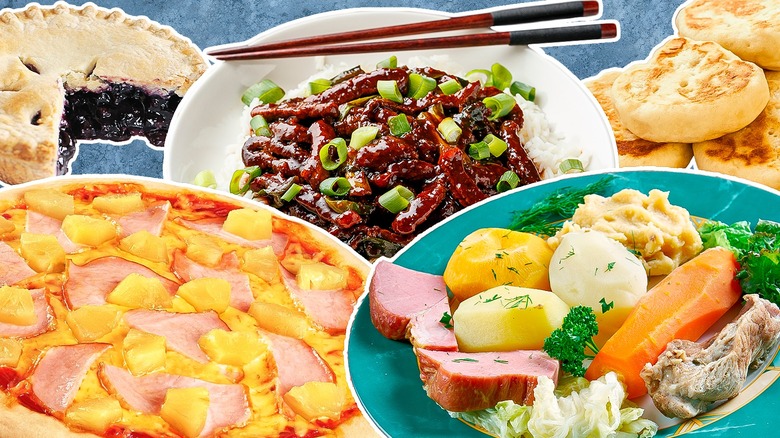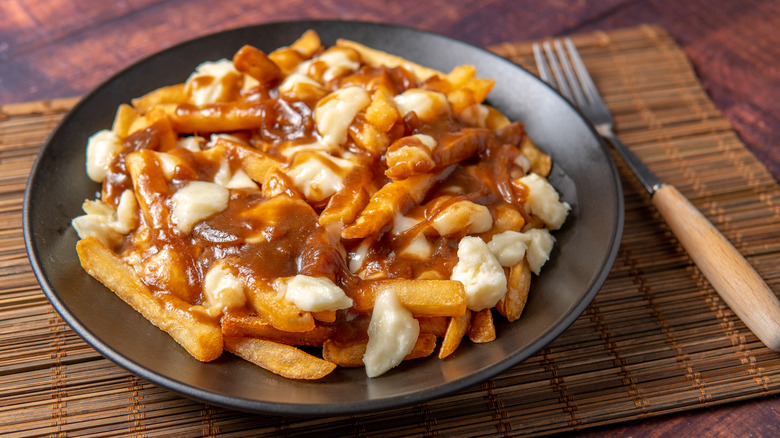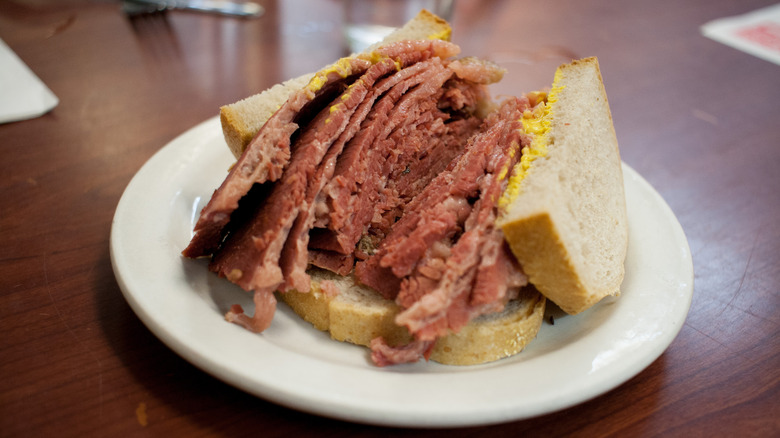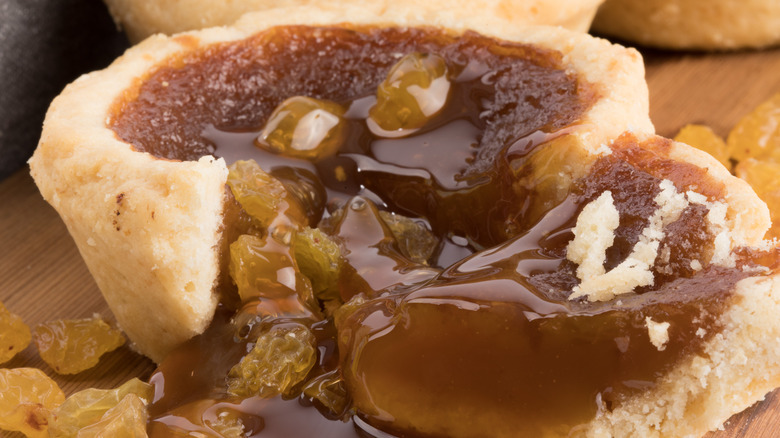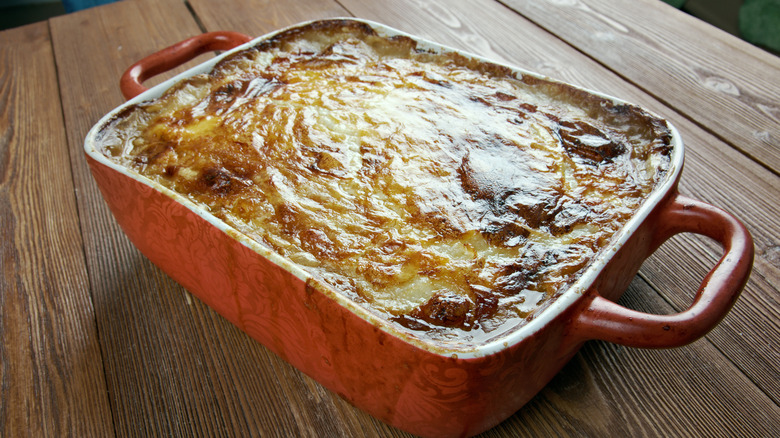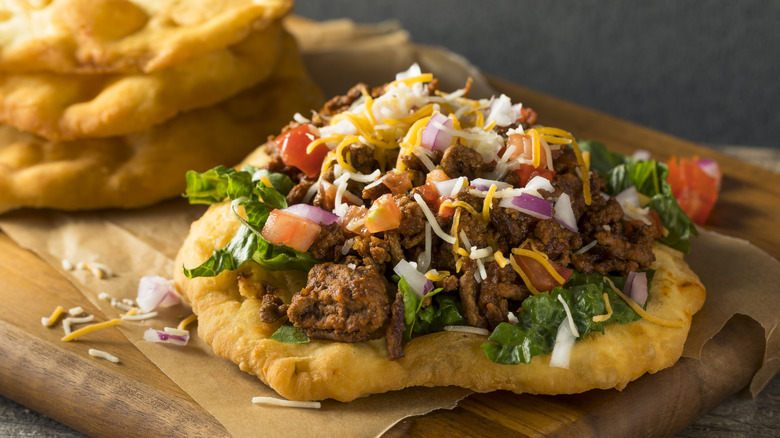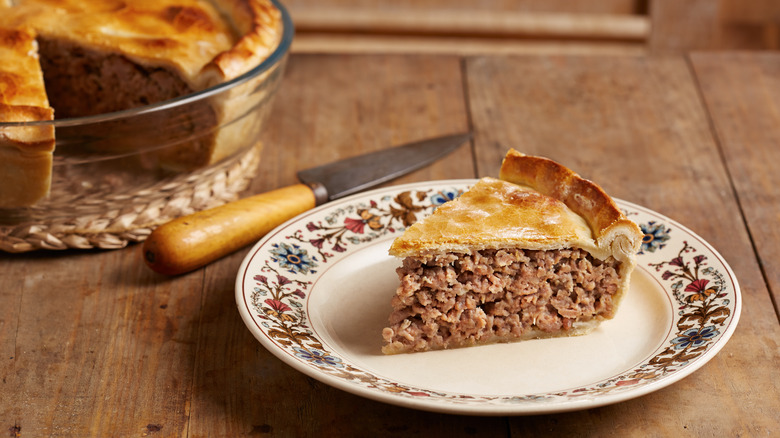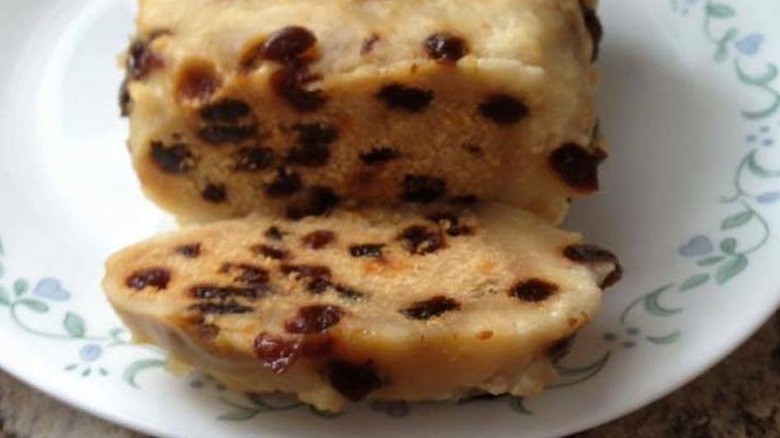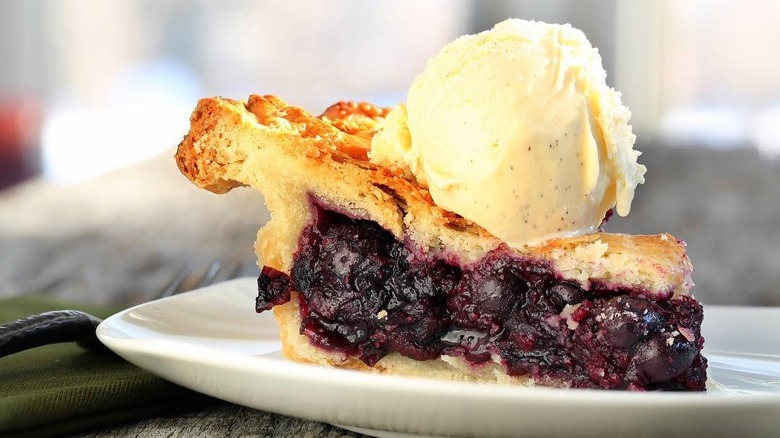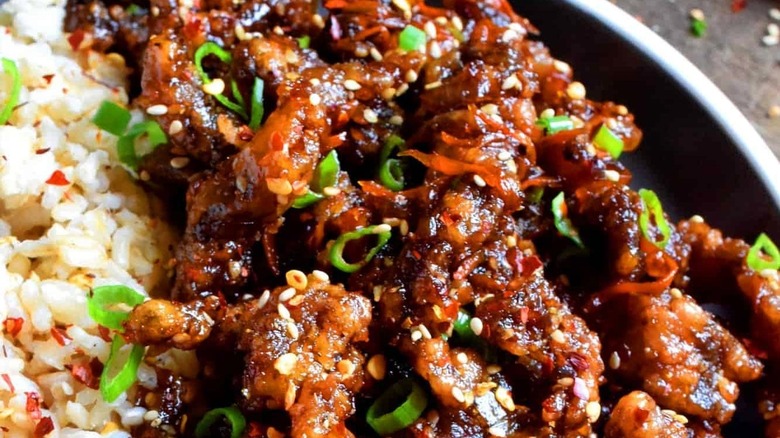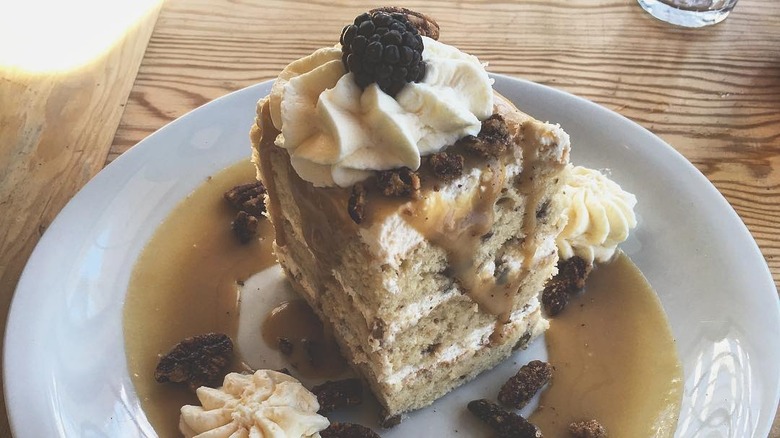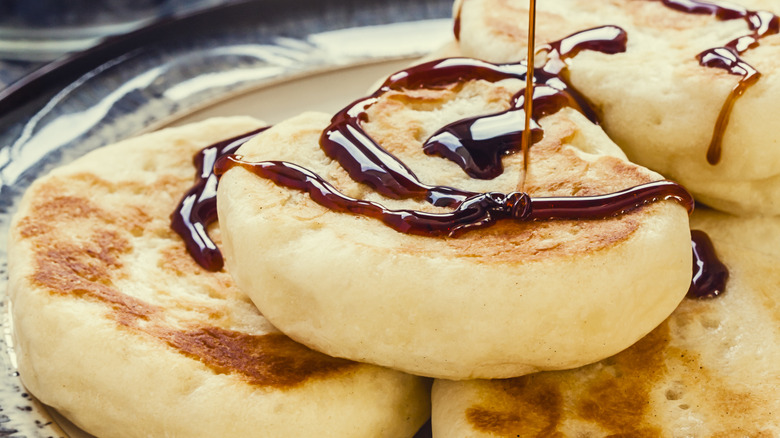15 Canadian Comfort Foods Everyone Should Try
There are many unique Canadian culinary delights that are just that — unique. While beyond its borders Canada's cuisine may be associated with specific exports like maple syrup and Canadian bacon, the country's culinary traditions are as varied as its provinces. They take inspiration from the many cultures — both immigrant and indigenous — that have roots in Canada's heritage. Canada officially adopted multiculturalism as a national policy back in 1971, and nowhere is this more apparent than in the bounty of comfort foods that are elementally Canadian.
While Canada's cuisine as a whole may be difficult to define, the individual dishes that are unique to regions of the Great White North reflect a vast, varied, and cumulative national culture. "It starts with ingredients that spring from the landscape and with traditional dishes steeped in the region's history and culture," says Canadian food writer Jennifer Cockrall-King (via The Canadian Encyclopedia). "Each chef reinterprets these elements to reflect a very personal vision of the land, food and people." There's so much to choose from, but these are our 15 favorite Canadian comfort foods.
1. Poutine
If there's one dish that's found favor beyond Canada's borders, it's the perennial poutine. Across Canada, it's enjoyed just as much in fast food as in fine dining restaurants — it looks remarkably elegant when topped with foie gras. Fries, curd cheese, and warm gravy comprise this simple, hearty trinity, and though poutine's exact origins are somewhat contentious, they all point to 1950s Quebec as its birthplace.
Cheese curds, a byproduct of the numerous fromageries dotting the region, were a widely available commodity in rural Quebec snack bars during this period – it was only a matter of time before someone added these squeaky bits of cheddar to an order of fries. As for who thought to top the pairing with gravy, one widespread legend suggests it was Fernand Lachance at the Café Idéal, who slathered gravy over cheese curd fries to keep them from going cold. Though cheese curds have their own textural delights when eaten plain, adding gravy melts them into the perfect consistency. Poutine purists insist that no other form of cheese will achieve the same satisfying effect.
As for the name itself, there is just as much speculation on poutine's etymology. It could have stemmed from "pudding" in English, which is pouding in French. But the best case for the name further solidifies the dish's Quebec roots — "poutine" is Quebecois slang for "mess." To make matters even messier, many Canadians enjoy eating poutine with vinegar or ketchup.
2. Nanaimo bars
The Nanaimo bar gets its name from a city on the east coast of Vancouver Island in British Columbia, which is said to be the wellspring from which this dessert once sprung. The bar is Canada's most iconic no-bake dessert. Various recipes suggest different proportions, but the trifecta remains the same: A graham and coconut crust, a custard center, and a top of chocolate ganache.
Popularized as a postwar dessert, Nanaimo bars likely came to be through the renewed availability of butter and sugar after WWII rationing (each layer of the bar requires copious amounts of both). While many aficionados might proclaim the dessert was around well before wartime, an official recipe didn't appear until 1952, when an entry for "chocolate squares" showed up in the "Women's Auxiliary to the Nanaimo Hospital Cookbook". It's possible that Nanaimo bars could have been masquerading earlier under a different name, as they have since been labeled with many other titles — the prayer bar, New York slice, and London fog bar are all more or less the same thing.
Though these alternate names might suggest origins from elsewhere, the Nanaimo bar's provenance is firmly rooted in Canada; it was voted Canada's Favorite Confection in a 2006 poll from the National Post. Today, Nanaimo boasts numerous versions of the classic recipe that can be found across the city. Some of the most noteworthy iterations enhance the classic Nanaimo bar flavors with mint, mocha, and maple bacon.
3. Montreal smoked meat
Treading a savory middle ground between corned beef and pastrami, Montreal smoked meat refers to the meat itself as well as the spiced mustard, rye bread sandwich to which the meat is typically added. Across Quebec, one can easily find Montreal smoked meat on the menu, and it has since found its way into other Canadian dishes, most notably as a favored addition to a platter of poutine.
The originator of Montreal smoked meat is purported to be Aaron Sanft, a Jewish immigrant from Romania. Sanft was advertising his smoked meat in Montreal in the 1880s, where he found an eager clientèle for his kosher brisket among the local factory workers (many of whom were also Jewish). Borrowing from the meat smoking traditions that have been a staple in Jewish cuisine for 2,000 years, Montreal smoked meat differs from other smoked varieties in that it is traditionally made from brisket, which gets spiced and then marinated.
"There were and still are several secret formulas based mainly on the combination of salt and spices used to coat the briskets," Eiran Harris, Archivist Emeritus of the Jewish Public Library in Montreal, explained while describing Montreal smoked meat in an interview with Erudit. "Variations in secret curing ingredients will affect flavor, but the most important aspect of a successful outcome is the cooking." Old-school methods let the meat marinate for up to 20 days before it was slowly smoked, resulting in especially tender and succulent meat.
4. Butter tarts
Butter tarts are another decadent treat that make ample use of butter. This rich confection is a dessert of quintessential Canadian origin. A single serving pastry tart filled with an amalgamation of egg, sugar, syrup, occasionally raisins, and always butter, it is possible these dainty delicacies are descended from the sugar pie, a European predecessor that likely emigrated with the French people who left Europe for France's North American colonies during the 17th century.
Among these immigrants were the "Filles du Roi", orphaned and widowed young women sponsored by the French king to travel to New France and marry the soldiers and farmers that inhabited the region. They make a compelling case for one of the butter tart's origin myths, as these intrepid women adapted their own baking recipes to accommodate the ingredients of their new homeland. While sugar may not have been in ample supply among the working classes during colonial times, maple syrup was an important resource for the indigenous peoples of the region. Though European colonists later cleared many acres of sacred maple forests, they did learn from the natives how to harvest maple syrup, a key ingredient in certain butter tart recipes.
An adaptation on a colonial dessert using native ingredients, butter tarts are the unique result of cultural melange. Today, butter tarts can be found almost anywhere in Canada, though they seem to be most revered in Ontario, which has hosted an annual Butter Tart Festival since 2013.
5. Rappie pie
Rappie pie was once the meat and potatoes of Canada's maritime provinces and has been an Acadian staple for over 250 years. Made from grated potatoes and (most commonly) chicken, it consists of simple ingredients but is a labor-intensive dish. Rappie pie has evolved to become more of a special occasion meal in Nova Scotia, New Brunswick, and parts of Prince Edward Island, but it reflects the history of Acadia as a creation unique to this region.
The Acadians were predominantly French immigrants to the present day coastal provinces of Canada, many of whom were deported during the Great Upheaval of the 18th century when the British took over the area. When they were permitted to return to the area, the Acadians had to settle in rocky terrain, which, while unsuitable for certain agricultural endeavors, proved to be optimal for growing potatoes. Consequently, potatoes became integral to Acadian cuisine, and they form the basis of rappie pie.
The dish is more casserole than pie, though the process of baking it in the oven does brown the potatoes on top into a sort of crust. The meat that gets cooked with the potatoes often varies — other common variations make use of rabbit, venison, and even clams. While some might top a serving of rappie pie with molasses, maple syrup, or chow-chow, it is just as enjoyable plain and it can still be found at a few restaurants in the maritime provinces.
6. BeaverTails
Beaver tails are nothing new to Canadian cuisine, as actual beaver tails were commonly eaten by the native peoples that hunted beaver well before European settlers established a fur trade. While today's BeaverTails are entirely vegetarian, their shape does bear an uncanny resemblance to the real thing. A fried pastry somewhere between a doughnut and a crepe, the contemporary BeaverTails became so popular after their debut at an Ontario community fair in the 1970s that they have gone from being a unique Canadian fair food to a fast-food fixture.
It was Pam and Grant Hooker of Killaloe, Ontario who introduced this deep-fried dessert to the world in the form of an old German family recipe. Today, the pastry has transformed into a brand in itself and is available at numerous permanent locations across the country. Though the classic variety topped with cinnamon sugar is delicious on its own, these tasty treats are now served with a variety of decadent toppings, among them peanut butter, marshmallows, and chocolate syrup. BeaverTails' success has since become so widespread that the franchise has expanded beyond Canada's borders, with locations in places as far away as Japan and the United Arab Emirates.
7. Bannock
Initially a Scottish food, bannock is a fried flatbread that fur traders introduced to North America. Quick, simple, and fortifying, bannock is made with flour, water, and baking powder, and seasoned with either sugar or salt. Today it is just as often baked and deep fried, but it was originally cooked in a pan or griddle over an open fire, making it a convenient meal for travelers. While indigenous peoples may have adopted this recipe from Scottish settlers, Canada's First Nations were making similar frybreads from flour made of corn, nuts, bark, and bulbs long before European settlers brought their recipes and cooking methods.
According to The Canadian Encyclopedia, native peoples were forced to rely on European bannock once the Canadian government pushed them off their lands and onto reserves with rationed ingredients to live off. Since then, bannock has transformed into a culinary testament to human resilience. "When people think of bannock, they don't think, 'Oh, settlers brought it to us," Tristan Jules, chef at Quaaout Lodge and Spa, told Thrillist. "No, we took the concept and made it our own dish. Go to any pow wow in North America, and I can guarantee you'll have bannock, frybread, or some variation of the two."
8. Tiger tail ice cream
Another combination that only exists in Canada, tiger tail ice cream is an intriguing mix of orange ice cream laced with black licorice swirls. While its exact origins remain unspecified, tiger tail has long been a Canadian fixture. According to Atlas Obscura, it first arose as a novelty flavor at soda fountains in the 1950s. While the combination might sound off-putting — the taste of black licorice is divisive on its own — there is a sort of unexpected magic in the fusion of orange ice cream's creamy citrus notes and licorice's woody sweetness. If Canadians are the only ones who've developed a taste for this juxtaposition, it could be that others simply need to try this pairing for themselves.
Tiger tail ice cream can be found across Canada, available in convenience stores and ice cream parlors alike. With variations in the name depending on the province, tiger tail and tiger tiger both describe the same phenomenon. The flavor isn't Canada's number one — a Narrative Research survey of 1,239 Canadians found that tiger tail doesn't even rank in the top ten. However, it remains a quirky cultural fixture, and those who do enjoy it are a passionate bunch. According to The New York Times, the flavor persists largely "because loyal tiger tail fans raise an enormous fuss whenever its future appears in jeopardy."
9. Tourtière
A Canadian take on meat pie, the double-crusted tourtière has been a holiday dish for hundreds of years, dating back to 17th century Quebec. Minced pork, mutton, or beef were traditionally incorporated into the dish, but tourtière has often been mixed with an array of local game, from rabbit to moose. What makes tourtière unique is the selection of spices used to season the meat; commonly cinnamon, nutmeg, mace, and cloves, which grant the dish a distinctive holiday flavor. Purists serve tourtière solely for the holidays, and usually late at night — after a midnight mass on Christmas Eve, or after the stroke of midnight on New Year's Day.
Though tourtière likely descends from a long-line of meat pies that date back to ancient times, one of the earliest recipes for the dish didn't appear until an 1840 cookbook, "La Cuisinière Canadienne", which may have contributed to the dish's continued and lingering popularity.
Today, according to Canadian Geographic, tourtière tends to be made from ground pork or beef, and it's often seasoned with cinnamon and thyme. Sometimes potatoes are also added to the meat mixture. Tourtière is typically only available during the holiday season, when these meat-filled pastries in rich, flaky crusts appear in varying shapes and sizes in Quebec's bakeries. As a topping, many Canadians eat it with ketchup.
10. Figgy duff
Though it isn't (and never has been) made from figs, this dish is another Canadian concoction served around the holiday season. Popular in Newfoundland and Labrador, figgy duff takes influence from the British figgy pudding immortalized in a well-worn Christmas carol. It gets its name from the region's Cornish heritage — "figs" were a Cornish name for raisins and "duff" another term for pudding.
Whether or not it was due to the similar rocky coastal terrain, Newfoundland and Labrador were regions that eventually attracted many immigrants from England's West Country, consequently drawing in many Cornish migrants and their traditional recipes. Figgy duff is one of the few surviving remnants of another time in the history of Canada's maritime provinces, and it reflects the lasting influence in Newfoundland as one of the longest surviving colonies of the British Empire. Figgy duff is a pudding in the British sense — a confection that is boiled or steamed and can be either sweet or savory, comprising a spectrum of consistencies that span from sweet almost-cakes to piquant, peppery haggis.
The figgy duff sticks to the sweet and is made primarily from flour, butter, sugar, and molasses (and, of course, "figs"), which get baked into a moist sort of bread pudding. The outcome is considerably saccharine, which may be why this duff still gets reserved for special occasions.
11. Hawaiian pizza
Contrary to the misleading misnomer, Hawaiian pizza really has nothing to do with Hawaii, and its attribution to Canada is fairly circumstantial too. It was Sam Panopoulos, a Greek immigrant to Canada, who is credited with dreaming up this combination in the 1960s. The only thing Hawaiian about the dish is that both ham and pineapple are common ingredients found among the islands of Hawaii. And the only Canadian thing about it — besides the fact that Panopoulos introduced it to the world through his restaurant in Chatham, Ontario – is that the ham it uses resembles Canadian bacon, though is not in fact the same thing.
The success of this sweet-yet-savory Greco-Canadian innovation may have been due to a mid-century cultural moment. Hawaii became an official US state in 1959, inspiring a surge in tropical tastes and an increase in pineapples imported from the island. As the BBC reports, Panopoulos' pineapple pizza came out around the same time as Golden Circle's "Tropical Recipe Book," which marked an influx of pineapple-centric dishes across North America throughout the 1960s. It was probably inevitable that pineapple would eventually find its way onto a pizza, but there was never a guarantee that it would have universal appeal. Though pineapple remains a divisive pizza topping, the fact that Hawaiian pizza originated in the Great White North might not be all that surprising — a name suggesting ocean breezes could have been especially enticing during a frigid Ontario winter.
12. Saskatoon berry pie
Saskatoons are a berry native to Canada's prairies and the northern American plains, where they are alternatively known as juneberries and serviceberries. Saskatoon berries thrive in colder climates, a symbol in themselves of Canadian hardiness, and are also packed with enough antioxidants to be considered an even greater superfood than blueberries. Their nutrient content and widespread availability made saskatoons an important food source for the indigenous peoples of the Prairies; the name saskatoon, as enRoute explains, comes from the Cree word for the berry, misâskwatômina. First Nations peoples have enjoyed saskatoons in many forms — in baking, for teas, as dyes, and as an integral ingredient in an ancient energy bar known as a pemmican. But the most widespread use of the berry today is as a local flavor of berry pie.
The city of Saskatoon in Saskatchewan shares the berry's name, hinting towards the province's great pride for this regional delight. Being as ubiquitous as they are beloved, saskatoon berries have inspired a widespread Saskatchewanian love for saskatoon berry pie. While nuttier and less sweet than other berry varieties, saskatoons' distinct flavor still makes for an exceptional pie filling of its own, creating something that is naturally just sweet enough without being overwhelmingly sugary. Though there is no one true recipe for the dish, this simple pie reflects the region's unique resources and culinary history. Saskatoon berry pie earned its place among the ranks of true Canadian cuisine in 2019 when it was featured on a Canadian postage stamp.
13. Ginger beef
A Chinese-Canadian dish, ginger beef is attributed to George Wong, a Chinese émigré to Calgary, Alberta who was experimenting with pseudo-fusion cuisine in the 1970s. The Silver Inn, a restaurant he ran with his wife, was part of a longstanding tradition of North-Americanized Chinese food in Canada. Leading up to the 20th century, discriminatory laws posed housing and employment limitations for Asian immigrants in Canada, which prompted many to start their own businesses. Restaurants were a popular choice and allowed people to adapt dishes from their homelands to suit a Westernized palate.
In hopes of wrangling more clientèle, Wong strove for equal parts creativity and simplicity in devising a new dish, though his experiments with beef posed an additional challenge with Calgarians as customers. Alberta is renowned the world over for its rich, grass-fed beef, which has acclimated meat-loving locals to a premium tenderness. After trying a few fairly traditional beef variations that weren't particularly successful, Wong discovered that battering the beef before frying it resulted in a crunchy outside with a tender interior — the perfect textural contrast.
Ginger beef was initially called exactly what it was, "deep-fried shredded beef in chili sauce", but its sweet-and-sour tang simultaneously thrilled and confused Canadian taste buds. "It caught on and became known as 'ginger beef,'" Karen Anderson, president of Alberta Food Tours, told Food Network, "because Canadians mistakenly believed there was ginger in the sauce."
14. Schmoo torte
A Manitoba specialty born out of Winnipeg's Jewish community, schmoo torte is a decadent dessert that can now be found throughout Canada, but it remains most popular in its province of origin. The confection came from the culinary prowess of Dora Zaslavsky, a Russian immigrant so beloved in her community for her cooking and unparalleled baked goods that she set up a family catering business. According to CTV News Winnipeg, she had long been famous for her towering tortes. But in 1948, she baked up something especially sumptuous after her son's request for a truly unique cake for his bar mitzvah.
A torte is usually denser than a cake, replacing much (and sometimes all) the flour that might go into a traditional cake recipe with nuts or breadcrumbs. But the schmoo torte blends the heavy with the light through pecans added to layers of sponge cake and whipped cream. For the finishing touch, once it's baked and iced, the entire schmoo gets covered in caramel sauce.
As for the name, there is much speculation on possible Yiddish etymologies that may have inspired the word. But 1948, the year the schmoo torte was born and Zaslavsky's son came of age, was the same year that Al Capp's Shmoo was introduced in his L'il Abner cartoon and became an instant sensation. The Schmoo torte was met with similar (albeit much more localized) success, and continues to be a regional specialty with no shortage of local acclaim.
15. Toutons
Halfway between a pancake and a biscuit, toutons make for a traditional stick-to-the-ribs kind of Newfoundland breakfast. Though the ingredients and cooking process are nothing complex, the dish is still a local favorite, perhaps because eating toutons "will make you happier than you ever knew was possible," as International Traveller put it.
The Dictionary of Newfoundland English suggests the recipe for toutons has existed under the same name since the early 1800s, though earlier origin theories suggest an adaptation of culinary methodologies from the British Isles. Characteristically thicker than the typical pancake, toutons are made from dough left to rise overnight and are traditionally fried in pork fat. The toppings of choice are molasses and butter, or occasionally jam. As a further testament to the region's British influences, toutons are sometimes paired with baked beans — perhaps a Newfoundlander take on the traditional English breakfast.
While the touton recipe is timeworn and revered for its simplicity, restaurants in Newfoundland have started to experiment with this classic. The owners of Touton Lane in St. John's, for example, have discovered that toutons make for an ideally innovative sandwich, a sort of Maritime arepa equally suited to sweet and savory combinations. While fried dough is a ubiquitous concept that belongs to most cuisines of the world, the continued popularity of toutons is indicative of simplicity being no less delicious.
